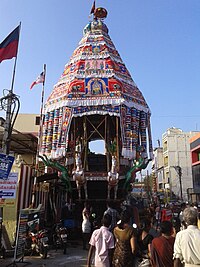The temple priests perform the puja (rituals) during festivals and on a daily basis. Like other Shiva temples of Tamil Nadu, the priests belong to the Shaiva community, a Brahmin sub-caste. The temple rituals are performed five times a day; Ushathkalam at 6:30 a.m., Kalasanthi at 8:00 a.m., Uchikalam at 12:00 a.m., Sayarakshai at 5:00 p.m., and Ardha Jamam at 8:00 p.m.
Each ritual comprises four steps: abhisheka (sacred bath), alangaram (decoration), naivethanam (food offering) and deepa aradanai (waving of lamps) for both Nageswarar and Periyanayagi.
The worship is held amidst music with nagaswaram (pipe instrument) and tavil (percussion instrument), religious instructions in the Vedas (sacred texts) read by priests and prostration by worshipers in front of the temple mast.
There are weekly rituals like somavaram (Monday) and sukravaram (Friday), fortnightly rituals like pradosham and monthly festivals like amavasai (new moon day), kiruthigai, pournami (full moon day) and sathurthi. Mahashivaratri during February - March is the major festivals celebrated in the temple.
The major festival of the temple is the Brahmotsavam temple during Tamil month of Panguni when the Sun's rays fall directly on the image in the sanctum.

Nageswaran chariot
Tirugnana Sambandar, a 7th-century Tamil Saivite poet, venerated Nageswarar in ten padigams in Tevaram, compiled as the First Tirumurai and second Tirumuari. Appar, a contemporary of Sambandar, also venerated Nageswarar in 12 padigams in Tevaram, compiled in the Fourth, fifth and sixth Tirumurai. Sundarar, the 8th century Nayanmar revered Nageswarar in seven padigams, which is compiled in Seventh Tirumuari.
As the temple is revered in Tevaram, it is classified as Paadal Petra Sthalam, one of the 275 temples that find mention in the Saiva canon.
The temple is counted as the 52nd in the list of temples in the northern banks of Cauvery. The temple is counted as one of the temples built on the banks of River Kaveri. The Sun rays falling on the image of Shiva is considered as the worship of Surya.
Twelve Shiva temples are connected with Mahamaham festival which happens once in 12 years in Kumbakonam. They are Kasi Viswanathar Temple, Kumbeswarar Temple, Someswarar Temple, Nageswaran temple, Kalahasteeswarar Temple, Gowthameswarar Temple, Kottaiyur Kodeeswarar temple, Amirthakalasanathar Temple, Banapuriswarar Temple, Abimukeswarar Temple, Kumbakonam, Kambatta Visvanathar Temple and Ekambareswarar Temple.
As per a Hindu belief, people troubled by Sarpa-dosha or Malefic effects Rahu-Kethu seek a relief by offering prayers in a single day to Kudanthai or Kumbakonam Nageshwarar in the morning, Thirunageshwaram Naganathar at the noon, Thirupamburam Pambureswarar in the evening and Nagoor Nageshwarar or Naganathar temple at night.